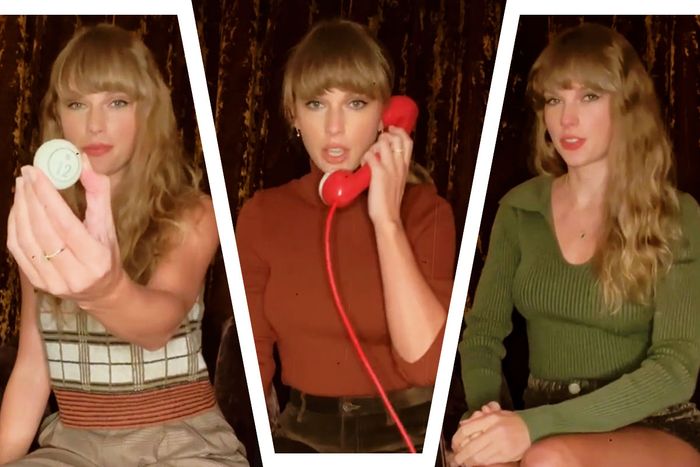
At midnight on September 21, Taylor Swift was in her element. It was a month before the release of her just-announced tenth album, Midnights, and she had decided to start the bread-crumb trail of information by debuting a new track name on TikTok. The plan would be to unveil one per night pulled from a bingo-ball cage. As luck would have it, she drew her favorite number first: 13. The title, “Mastermind,” set off weeks of speculation about everything from what each song could be about to the way she was holding the vintage telephone she used in every video to the nails she was wearing (which were the same ones she had for her talk at the Toronto International Film Festival).
It was a Taylor Swift we hadn’t seen in years. She had announced her previous two studio albums, folklore and evermore, less than 24 hours before they were released, forgoing a traditional rollout. And while she warned us about her “Taylor’s Version” rerecordings of Fearless and Red last year, many of those cards had already been on the table via track lists her fans knew inside and out, leaving her teasing to little more than a word scramble. The last time her pre-album antics went this deep was before the pandemic, in 2019, when she had us scouring music videos for Easter eggs and deciphering the pins on a jacket around Lover. With Midnights, Swift hasn’t just left the era of folklore and evermore behind — she has made clear that those intimate, impromptu rollout strategies were just a detour.
Swift isn’t the only one. The past 12 months have been full of traditional album rollouts from A-list artists that grabbed and held fans’ attention. The biggest shoe to drop: Beyoncé, who after a trilogy of game-changing surprise releases, shocked listeners by announcing Renaissance and an accompanying single in advance — a befitting retro touch for an album steeped in musical history. Before her, pop’s reigning classicist, Adele, made her return with simultaneous magazine covers for Vogue and British Vogue, following those up later with an album announcement and single, “Easy on Me.” Harry Styles introduced Harry’s House with a trailer in March, followed by “As It Was” and two weekends of Coachella-headlining sets complete with song debuts and special guests. After years of speculation around his final project for Top Dawg Entertainment, including a Super Bowl appearance with no new material, Kendrick Lamar continued his trend of directly addressing fans by announcing Mr. Morale & the Big Steppers in a letter — then kept them waiting for a month until release week, when he surprised us with “The Heart Part 5.”
Less than two years ago, I wondered if the pandemic and the artistic freedoms it afforded had killed the long album rollout for good. It wasn’t just that Swift, the queen of musical teasing, had dropped two surprise records — it was that Ariana Grande released positions on little notice and a slew of rappers went No. 1 off of records with zero lead-in. Meanwhile, albums that had full pop rollouts, like Dua Lipa’s Future Nostalgia and Katy Perry’s Smile, underperformed on arrival. That trend seemed to hold through 2021, when stars like Justin Bieber treated their rollouts like chores as others, like Lorde, struggled to leverage rollouts into streams and sales.
By the time Swift unveiled the surprise-drop evermore, she was experiencing diminishing returns on the charts. It was her lowest debut in more than a decade at just 329,000 equivalent units — less than half of what she’d moved for folklore. Part of that was due to a staggered release pattern for CDs and vinyl records on top of new chart rules around bundling. But she felt a similar impact on the Hot 100, where single “willow” debuted at No. 1 but fell to No. 38 in its second week. Earlier in 2020, “cardigan” only fell to No. 8 — at the time, it was a testament to the novel shock of a surprise drop, in the throes of the pandemic, from a star who used to be the rollout’s biggest proponent.
But on the charts today, keeping attention is more important than getting it. It has never been easier to game the system to score a No. 1 — just look at the high turnover on the charts this decade. For pop stars like Swift, Adele, and Beyoncé, long rollouts have been key to keeping people talking and listening. Adele’s “Easy on Me” stayed at No. 1 for ten nonconsecutive weeks, buoying 30 for six weeks on the album chart and a dominant 839,000-unit debut. Yes, Swift and Adele are two of the only artists who can command the charts that well today. As for the other? That would be Drake, who fared significantly less well this year with the surprise release of Honestly, Nevermind, which moved just over 200,000 units — a fraction of how he did last year with Certified Lover Boy (which, though it didn’t have a full rollout, did have months of anticipation behind it after Drake first teased it nearly a year before and beefed with Ye ahead of the release.).
Beyoncé reaped different benefits from her pre-album plans. While her surprise-release strategy wasn’t broken, it had one bug: Beyoncé hadn’t earned a solo No. 1 song in more than a decade (likely due to how holistic Beyoncé and Lemonade were as visual albums). That changed with Renaissance, thanks to Beyoncé actually leading off with “Break My Soul.” The song entered the chart in the top ten, dipped in the second week, then, thanks to a mix of strategies old (a radio push) and new (a flood of remixes), finally summited the Hot 100 the same week Renaissance hit No. 1. The feat is all the more impressive when you remember that “Break My Soul” still doesn’t have a music video. Styles’s Harry’s House rollout worked similarly — “As It Was” wouldn’t now be one of the longest-running No. 1s in history without its head start a month-and-a-half before the album came out. In fact, the release of Harry’s House helped the song bounce back to No. 1 in June and July — only interrupted for one week by Drake.
Styles and Beyoncé didn’t tip their hands too much with a conventional two or three singles — all it took was satiating fans enough with one song while building enough anticipation to burst when the album arrived (even, in Bey’s case, despite leaks days before). And crucially, Beyoncé didn’t give up all of the creative freedoms of a surprise release. She was able to give fans the album and keep them waiting for impending visuals, effectively developing a hybrid between a rollout and unannounced drop. Similarly, Lamar and Swift could still forgo prerelease singles to apparently little consequence on the albums chart. (In Swift’s case, it’s probably a benefit — she has been notoriously bad at picking lead singles, and letting fans and critics take in folklore all at once seemed to play into its reception as an auteurist, “indie” album. A well-timed music video for “Anti-Hero” will still likely all but ensure another No. 1 on the Hot 100.)
Of course, there’s one major exception to the recent rollout rule. Bad Bunny has spent 13 weeks at No. 1 with Un Verano Sin Ti, an album he released by surprise in May. What’s more, it has never left the top two, regularly posting more than 75,000 units per week. But Bad Bunny’s success grew out of a specific formula: He’s the biggest Latino pop star the U.S. has ever seen, and Un Verano is the biggest Spanish-language album, playing to a major gap in the listening market that is only growing. Still, at 274,000 units, the album posted first-week numbers below those of Adele, Beyoncé, Styles, and Lamar — it has just benefited from a steady post-release strategy with rollout-level planning. Un Verano came at the right time, early enough to establish itself as a summer soundtrack, and Bad Bunny came out of the gate ready to promote with a massive stadium tour and music videos. If anything, its success shows how much legwork it can take to make a surprise release stick.
Nearly ten years ago, that wasn’t the case. Beyoncé’s surprise drop for Beyoncé, combined with a full set of music videos, was so novel that it commanded attention on release and retained it for months afterward as fans processed it all. That had been a major benefit to the surprise strategy — the rollout could happen after the album was out and keep it in the mix. But now, there are exponentially more things fighting for our attention — especially online. An unannounced album still makes a splash, but once fans move onto the next thing days or weeks later, it can be left floundering. Give fans a bit of advance warning, though, and they’ll stream, speculate, and stay plugged in until the album comes — likely with a longer tail to digest the record once it hits. Tellingly, Swift is now focused on keeping fans’ attention, posting a release-week calendar on Instagram complete with music-video drops, late-night appearances, and a “special very chaotic surprise.” With any luck, she’ll have people talking about Midnights for many more midnights.





